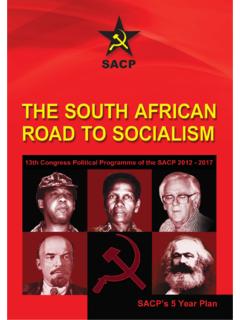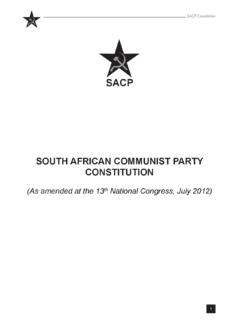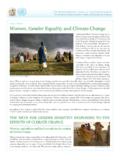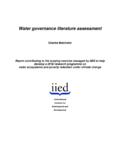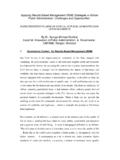Transcription of SACP DISCUSSION DOCUMENT ON RURAL …
1 1 SACP DISCUSSION DOCUMENT ON RURAL development POLI C Y FR AM EWORK 1. Introduction RURAL dev elop ment is about the human d evelop ment of the RURAL p oor, which includes, but is not reducible to agr iculture and land r edistribution. However land and agrar ian transformation should be the linchp ins for our RURAL develop ment. The p ap er s main objective is to assist our South African Commun ist Party in its efforts to develop a policy and p rogramme aimed at addressing the scourge of RURAL p overty in the country and campaigns that it may embark up on to advance the struggle against RURAL p overty . To this end, the p ap er lay s out a brief h istorical context of the agrarian question, identifies the main causes, the extent and dep th of RURAL p overty . Simult aneously it reflect s on t he gap s in current RURAL develop ment p olicies of governm ent , suggest s app rop riat e RURAL deve lop ment p olicy inst rument s and app roaches for effect ive rur al p overty eradicat ion, and fina lly reco mmends camp ai gns t hat t he Part y may embark up on t o mobilise and or ganise RURAL co mmunit ies a gainst t he root s of raci alised and gend er-based rur al p overty.
2 Indentify ing the main causes of RURAL p overty , the p resentation argues that the resolution of the South African agrar ian question in favour of the white industrial and agricultural cap ital has much to do with the p overty and the sharp racialised and p atriarchal uneven development that charact erises cont emp orary Sout h Africa. Whilst assets, such as land and livestock, were stripp ed from the African majority , they were simultaneously denied the op p ortunity to develop new collectively owned assets by restricting access t o financi al, infrast ruct ural and educat ional r esources. We furt her p oint out t hat t he p ost -1994 economic p olicies and ap proaches did not help much in ridding the country of RURAL p overty . They further widened the gap between the p oor and the rich and in themselves became a constraint to RURAL develop ment.
3 The resolution of our co lonial agr arian question, therefore, will b e mor e p ersuasive if it is linked to eradication of poverty through the transformation of our colon ial industrial structure as a necessary condition for socialist transition. Conversely , land r edistribution will b e less p ersuasive if it is just for moral reasons. In other words, land reform and agrar ian strategy should be linked to transformin g our colon ial industrial structure to (a) diversify our economy and reduce our dep endency on global cap italism. To this end, we should anchor our RURAL develop ment strategy on distributing p roductive assets such as land, instruments and socio-economi c infrast ruct ure t o t he RURAL p oor. Because the b alan ce of class forces will determine the policy outcomes of the RURAL dev elop ment st rategy , t herefore it is imp ort ant t o conduct an emp irical class analysis of the count ryside in order to identify social forces for and against RURAL chan ge.
4 2 2. The agrarian and land que st ion in it s brie f conte xt In the context of a transition from feudal or p re-cap italist mode of p roduction, the contradiction had been the availabi lit y of t he p rop erty less class t o sell its labour p ower t o cap it al. This contradiction had been resolved through d ispossession of the p easantry and other simp le commodity p roducers. Once capitalism was installed, the debate h ad b een: (a) whether the p easant s will wit her away or will be maint ained, but articulat ed t o t he dominant cap italist mode of production. And (b) How does the cap italist mode get installed in p re-cap italist social formation that is whether from below or from above? In colonial contexts, the key agr arian question had b een: how to get labour p ower to extract raw materials and gen erate surp lus from the p easants in order to fund the colonial state.
5 Like in many co lo nia l s o ci et ies, the agrar ian qu estion was resolved in the interest of minin g and agr icultural cap itals. Land d isp ossession was used to establish a coer cive labour system that would ensure that there was a constant and sufficient sup p ly of cheap labour to both cap italist agr iculture and minin g. Furthermore, the mass removals resulting from the implementation of the 1913 Land Act were a source of great suffering and hardship for the Africans starvation in grossly impoverished co mmunities in the ov ercrowded and underdevelop ed reserves became the order of the day . They were forced to take up wage labour on f arms or min es. Once cap italism was inst alled in Sout h Africa, African peasant s p roduct ion was nicely articulated to the dominant capitalist accumulation firstly through unequal exchan ge with colonial merchant cap ital and later through p rovision and rep roduction of cheap labour p ower for minin g and a gri cultural capit als.
6 Put differently, African p easant p roduction had two functional roles, namely : (a) rep roduction of cheap labour, (b) Served as a market for white agricultural cap it al. T he t radit ional leadership p lay ed a major in cont rolling t he African RURAL inhabit ant s. Of course, the African inhabitants have never been homogenous in class terms. But the majority of the African RURAL inhabitants have been Africans, and in many instances living side by side with white commerc ial farmers. When the African subsistence farming, oftenly undertaken by women, in the reserves were beginnin g to less productive, instead of providing more land, the Ap artheid state, amongst other things and further denied the RURAL more land. Consequently RURAL p overty was deep ened. In post-colonial situations, the post-colonial elites and global cap ital basically exploited the p easants through different mechanisms includ in g unequal exch an ge.
7 In short colonial and post-colonial societies did not transform or resolve the agr arian qu estion in a manner that resolved the colonia l indust rial st ruct ure. T hese economies st ill dep ended on t he met rop olis for durable consumer goods and p roductive consumer goods. 3 3. Agrarian and land que s t ion and RURAL pove rt y in pos t - 1994 South Af rica As a result of this sy stematic p rocess of disp ossession and exp loitation taking p lace for more t han t hree cent uries, at t he advent of a democratic p olitical d isp ensat ion in 1994, South Africa was regarded as havin g one of the most skewed distributions of economic p roductive resources, income and wealt h. The outcomes of the 1994 negotiated settlement which maintained the key p illars of cap italism set necessary conditions for the rep roduction of workin g class, includ in g RURAL p overty.
8 The willin g-buy er-willing-buy er m arket driven p roduct ive p rop erty dist ribut ion model further blocked the p rosp ects for radical land reform. In instances where land is transferred it is just for re-feudalization of society and moral reasons, NOT accomp anied by serious economic sup port measures. This has also led t o t he st rengt hening of t he p ower of t he t radit ional le aders, whilst t he RURAL masses are increasingly becomin g t he rec eip t s of p at ernalist ic welfarism and p eriodic election votin g fodder for the p olitical e lite. In an at t emp t t o redress the economic inequal ities referred t o above, in 1994 the government formulated the Reconstruction and Develop ment Programme (RDP) followed by the Growth, Employ ment and Redistribution (GEAR) strategy in 1996. Using the latter the gov ernment p ut strong emphasis on state asset restructuring and p rivatisation, downsizing of the p ublic sector and trade liber alisation aimed at reducin g bud get deficit (FAO, 2002).
9 Though GEAR produced results in terms of budget deficit decrease, imp roved revenue collection, skewed economic growth rate increase and, the economy kep t on shedding jobs in their millions and strategies aimed at job creation cou ld not stem the tide of unemp loyment, and int erest rat es st ill remain ed quit e hi gh p roving d isast rous for t he smallholder farm in g sect or. T he p redominant ly whit e agricult ural sect or was also affected under neo-liberal p olicy. It changed from a h i ghly re gulat ed and financia lly subsidised sect or t o a dere gu lat ed one wit h stat e support for inp uts and mech anical services and p rice control on commodities abolished and marketin g deregulated. Control boards were dismantled. These changes have p roduced contradictory outcomes within the agricu ltural sector. On one h and, the exclusively white commer cial agriculture has beco me more co mp etitive and p roductive.
10 On the other hand, trade libera liz at ion int ensified comp et ition within Sout h African agricu lt ure wip ing out some of t he white farmers. M any of the white farmers turned p roductive land into game farms as one of the responses to this comp etition. This has intensified the concentration and centralisation of agr icult ural c ap it al in t he hands of cap it alist monop olies which also collude in set t ing p rices for agr icult ural co mmodit ies. T his concent rat ion p rocess has furt her cont ribut ed t o t he mass exp ulsion of farm labourers from the country side, and to the undermining of the viability of many RURAL t owns. M any of t he current RURAL t ownship service delivery p rot ests are not unrelated to the imp act of p ost-1994 agricultural liberalisation. Ironically , the liberalisation p rocess which was meant to make our a gricult ural sect or more comp etit ive has a lso result ed in South Africa beco min g a net food imp orter.
